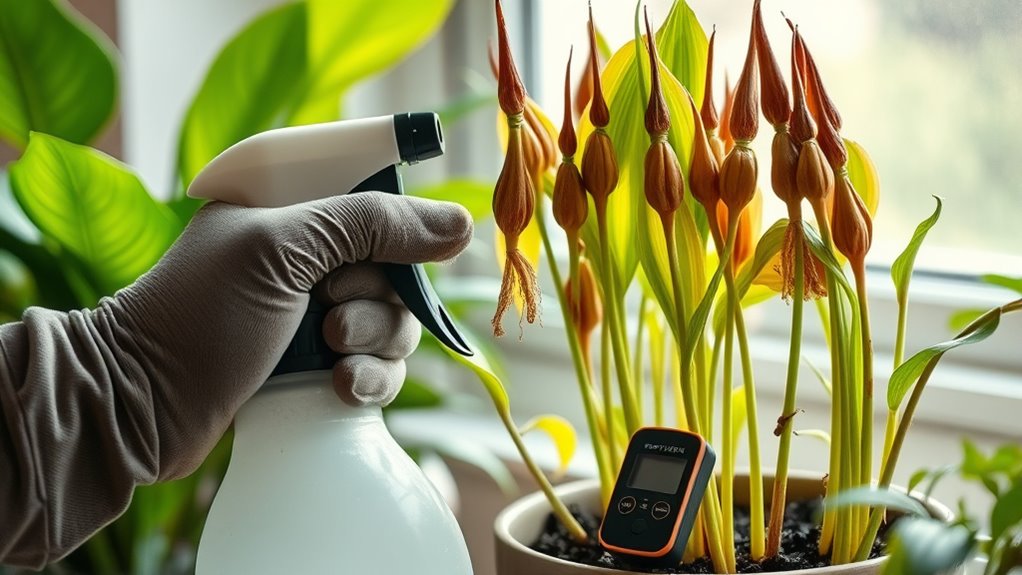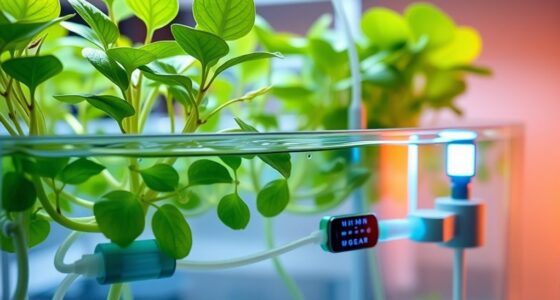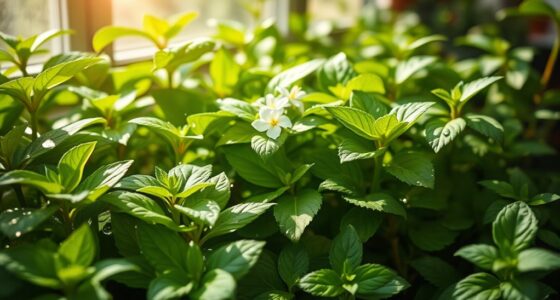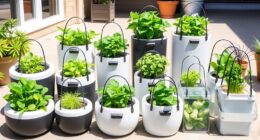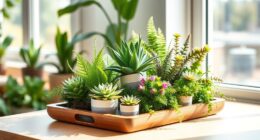When your plants start wilting, act quickly by checking for common signs like drooping leaves, yellowing, or soft roots. Guarantee you’re watering deeply and regularly, adjusting for soil moisture needs. Inspect for pests or diseases and verify proper light placement. Improving humidity and providing essential nutrients can also help. If you keep these steps in mind, you’ll quickly identify solutions to revive your stressed plants and prevent future issues. More tips follow to support healthier growth.
Key Takeaways
- Observe leaf discoloration, drooping, or curling to identify early signs of stress or dehydration.
- Check soil moisture regularly; water deeply and consistently to prevent drought stress.
- Inspect roots for rot or damage, and improve drainage if necessary.
- Optimize environmental conditions—control temperature, humidity, and air circulation.
- Use proper fertilization and adjust light exposure to support plant recovery and resilience.
Recognizing the Signs of Wilting and Stress in Plants
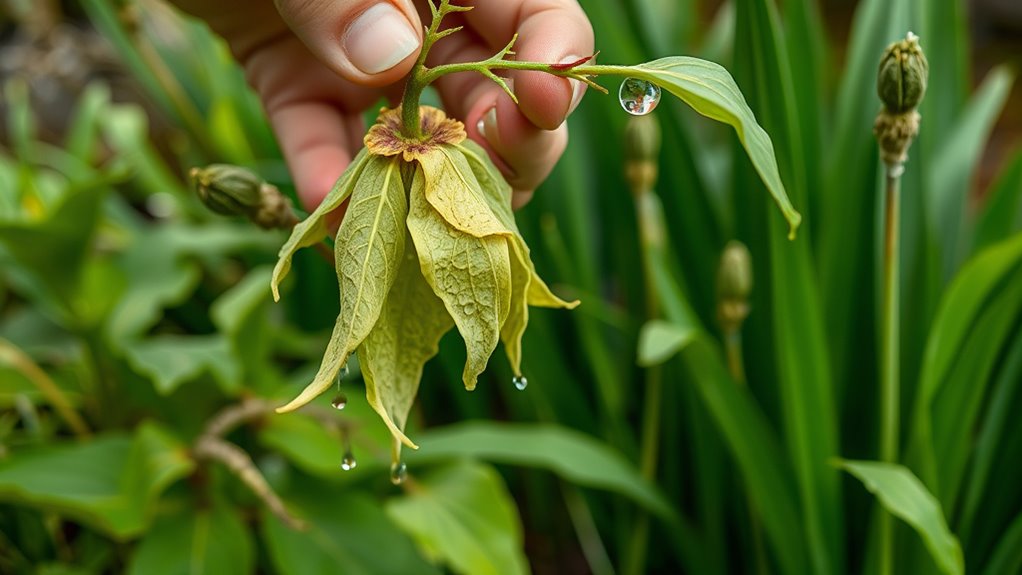
Plants often show signs of stress before they completely wilt, so paying attention to subtle changes can help you act quickly. One early sign is leaf discoloration, where leaves turn yellow or brown, indicating the plant isn’t getting enough nutrients or water. You might also notice leaves drooping or curling, which signals water stress. Root rot can be a hidden problem, often revealed when you inspect the roots—if they’re dark, mushy, or foul-smelling, it’s a clear sign of overwatering or poor drainage. Recognizing these signs early allows you to diagnose potential issues and intervene before the plant’s condition worsens. Being observant and proactive is key to preventing full wilting and saving your plant from further stress. Additionally, maintaining proper watering techniques can significantly reduce the risk of stress-related problems.
Common Causes of Plant Stress and Wilting
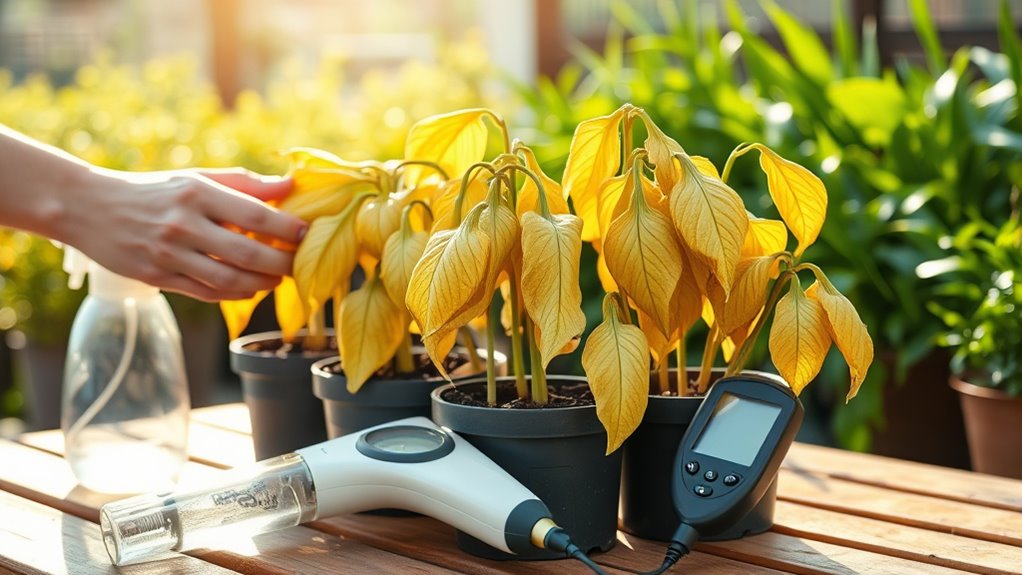
Many plants wilt because they don’t get enough water, so it is crucial to water them properly. Environmental factors like extreme heat, cold, or strong winds can also stress your plants and cause wilting. By understanding these common causes, you can take steps to keep your plants healthy and thriving. Additionally, exposure to airborne pollutants such as dust, pollen, and VOCs can contribute to plant stress, especially indoors where air circulation may be limited.
Insufficient Watering Practices
One common mistake that leads to plant stress and wilting is not providing enough water. When you ignore proper watering frequency, your plants can quickly become dehydrated, causing drought stress. It’s essential to water deeply and consistently, especially during hot or dry periods. Underwatering prevents roots from absorbing necessary nutrients, weakening the plant’s overall health. You might notice wilting leaves or dry, brittle soil—signs that your plant needs more water. Keep in mind that watering too infrequently or shallowly can do more harm than good. To avoid drought stress, establish a regular watering schedule tailored to your plant’s needs, ensuring the soil remains moist but not waterlogged. Proper watering practices are key to preventing stress-induced wilting and promoting healthy growth. Additionally, understanding the importance of high contrast ratios in visual displays can be metaphorically related to recognizing the subtle signs of plant stress before they become severe, enabling timely intervention.
Environmental Stress Factors
Environmental stress factors are common causes of plant stress and wilting, often disrupting the plant’s ability to grow and thrive. One key factor is soil pH; if the soil is too acidic or alkaline, nutrients become unavailable, weakening the plant. Adjusting soil pH can restore nutrient uptake and improve health. Poor air circulation can also cause stress by trapping humidity and promoting fungal diseases, which can lead to wilting. Guarantee your plants have enough space around them and avoid overcrowding to improve airflow. Additionally, sudden temperature changes or exposure to harsh sunlight can worsen stress. By managing soil pH levels and promoting good air circulation, you help your plants recover from environmental stress and prevent future wilting issues. Using eye patches can be a helpful analogy for protecting delicate plant tissues from environmental damage.
Checking Soil Moisture and Watering Needs

Checking soil moisture is the first step in determining whether your plants need watering. To do this, insert your finger about an inch into the soil; if it feels dry, it’s time to water. Understanding your plant’s soil composition helps, as different soils retain moisture differently—sandy soil drains quickly, while clay holds water longer. Regularly checking moisture levels prevents overwatering or underwatering, both of which stress your plants. Adjust your watering frequency based on the plant’s needs and the soil type. Avoid watering on a fixed schedule; instead, rely on moisture checks. Monitoring HEPA filtration can also be useful in detecting airborne pollutants that may affect plant health, especially indoors. This approach ensures your plants get only what they need, promoting healthy growth and preventing wilting caused by drought stress or waterlogging.
Inspecting for Pests and Diseases
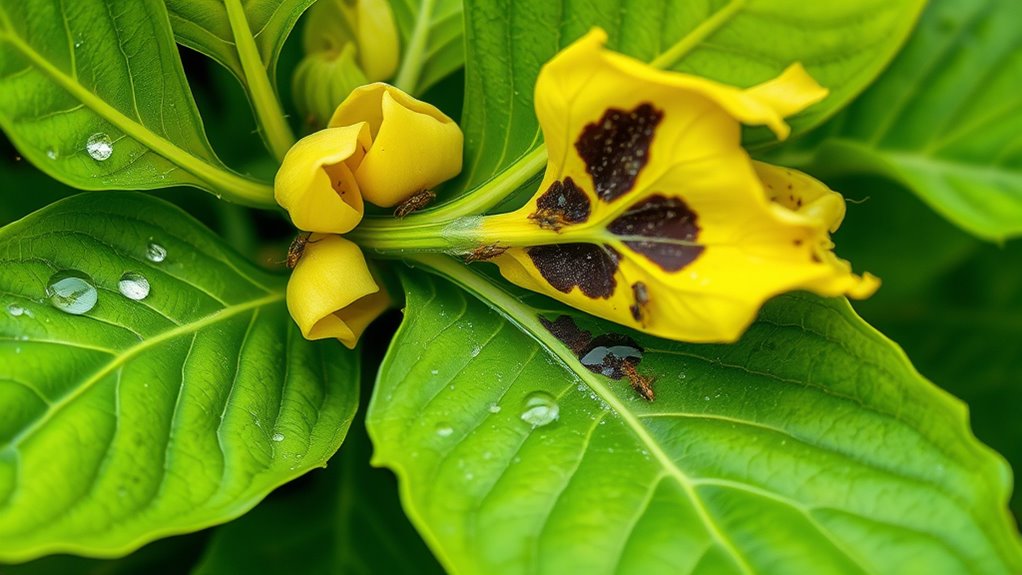
Regularly inspecting your plants for pests and signs of disease is essential to catch problems early before they cause serious damage. Start by closely examining leaves, stems, and undersides for pest identification, such as tiny insects, webbing, or eggs. Look for disease symptoms like discolored, spotted, or wilting leaves, mold, or unusual growths. Addressing these issues promptly can prevent infestations or infections from spreading. Use a magnifying glass if needed to spot small pests or subtle symptoms. Remove visible pests by hand or with gentle sprays of water or insecticidal soap. Keep an eye out for any changes in plant appearance, as these often signal underlying problems. Early detection and targeted action are key to restoring your plant’s health and robustness. Additionally, understanding regulatory compliance related to pest control methods can help ensure the treatments used are safe and effective.
Evaluating Light Conditions and Placement
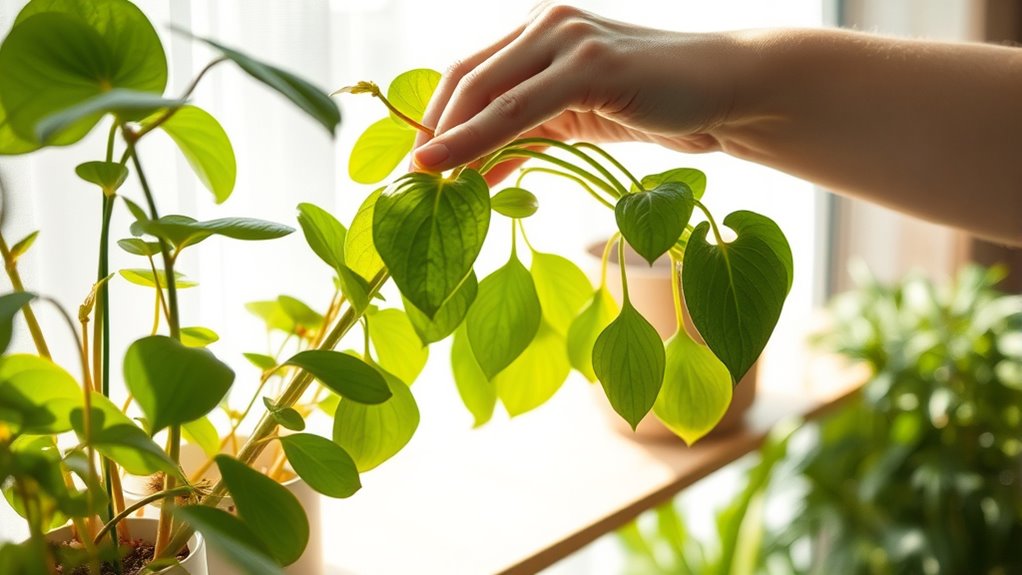
First, check how much sunlight your plant gets each day to determine if it’s enough. Then, adjust its position to guarantee it’s receiving the right amount of light for its species. Proper placement can make a big difference in helping your plant recover. Incorporating vertical storage solutions can also optimize space and improve overall plant care environment.
Assess Sunlight Exposure
Understanding your plant’s light needs starts with evaluating the sunlight exposure it receives throughout the day. Observe how much sunlight hits the plant and note the sunlight intensity—whether it’s direct, partial, or filtered light. Some plants have high shade tolerance, thriving in low light, while others require full sun. Pay attention to how long your plant spends in direct sunlight and if it shows signs of stress, like wilting or scorched leaves. Adjustments may be needed based on your plant’s specific light preferences. Keep in mind that overly intense sunlight can cause damage, especially for shade-tolerant varieties. Proper assessment of sunlight exposure helps you determine if your plant is in the right spot or if it needs repositioning for ideal health. Additionally, understanding the self watering planter system can assist in maintaining consistent moisture levels, especially when sunlight exposure varies.
Optimize Plant Position
Evaluating your plant’s light conditions and placement is essential to guarantee it receives the right amount of sunlight. Start by considering your garden orientation—north-facing, south-facing, or east-west—since this influences sunlight exposure throughout the day. Adjust your plant’s position accordingly to maximize or reduce sun as needed. Ascertain proper plant spacing to prevent overcrowding, which can block light and cause stress. If your plant is wilting, move it to a spot with appropriate light levels based on its species requirements. Avoid placing it in direct, harsh afternoon sun if it prefers indirect light. Regularly monitor how sunlight hits your plant and make adjustments to optimize its environment, helping it recover quickly and thrive. Additionally, understanding your lighting conditions and their impact on plant health can guide you in selecting suitable locations and care routines.
Adjusting Watering and Humidity for Recovery
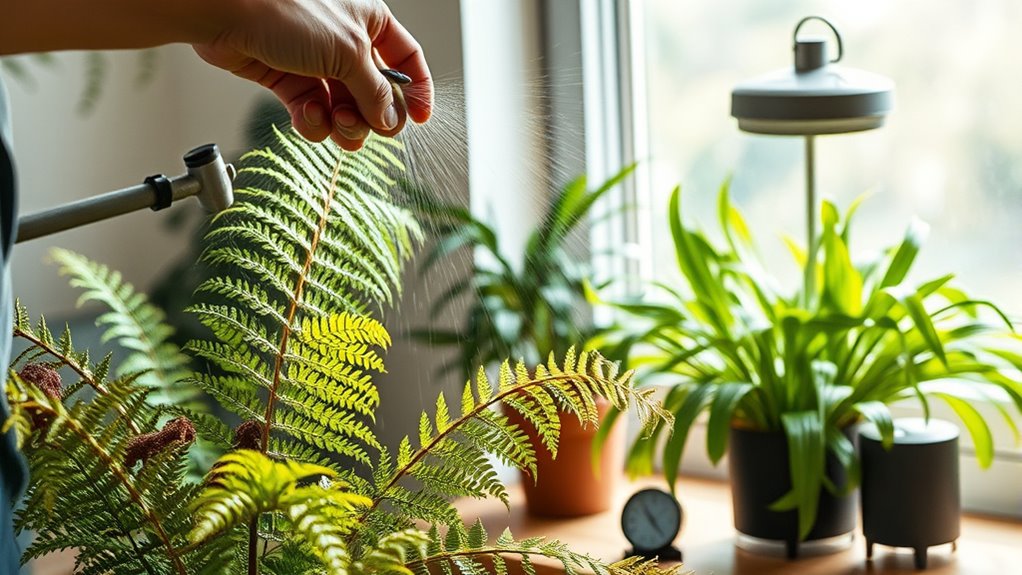
To help wilting plants recover, adjusting their watering schedule and humidity levels is essential. Start by evaluating the soil moisture—if it’s too dry, increase watering frequency, ensuring you water deeply but not excessively. Overwatering can cause root rot, so find a balance. Humidity control also plays a vital role; many plants thrive in higher humidity, especially indoors. Use a humidifier or place a tray with water nearby to boost moisture in the air. Consistent watering schedules prevent stress, while maintaining proper humidity encourages healthy transpiration. Monitor your plant’s response closely—adjust watering and humidity as needed to create an environment that supports recovery and promotes vigorous growth. Additionally, utilizing appropriate spray tips can improve the evenness of water distribution, ensuring your plant receives consistent moisture.
Providing Proper Nutrients and Fertilization

Providing proper nutrients and fertilization is essential for helping your wilting plants bounce back and thrive. Start by improving the soil with amendments that enhance nutrient availability and structure. Incorporate organic fertilizers, such as compost or fish emulsion, to deliver essential nutrients naturally. These fertilizers release nutrients slowly, promoting steady growth and recovery. Avoid over-fertilizing, which can stress plants further, and always follow recommended application rates. Check the soil’s nutrient levels with a test kit if possible, ensuring you address specific deficiencies. Proper fertilization encourages strong root systems, vigorous foliage, and resilience against future stress. Remember, healthy soil is the foundation for healthy plants, so ongoing soil management plays a key role in long-term crucial. Additionally, understanding signs of nutrient deficiency can help you tailor your fertilization approach more effectively.
Preventative Measures to Keep Plants Healthy
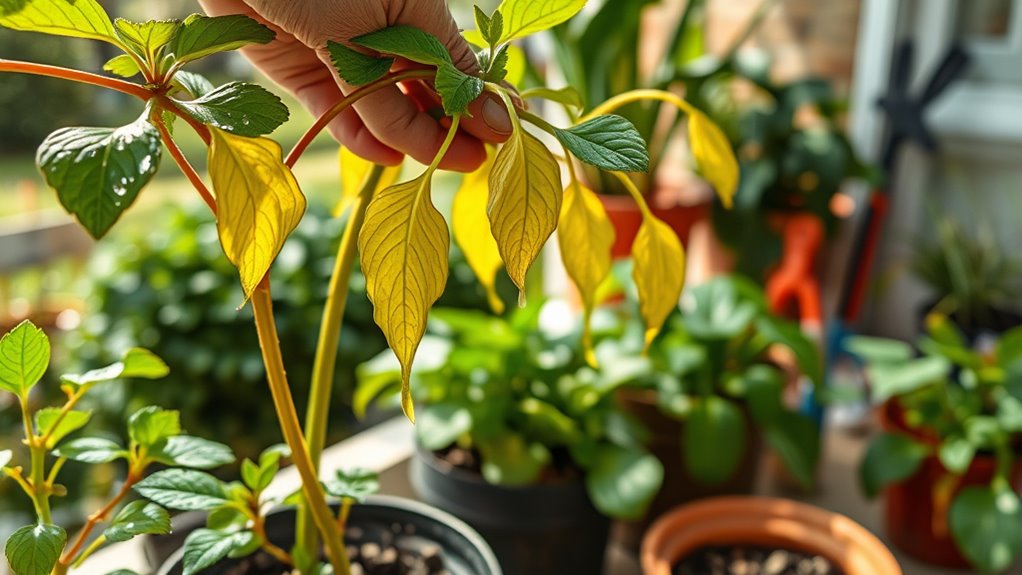
Maintaining healthy plants starts with preventive actions that reduce the risk of future problems. Regular pruning techniques help remove dead or damaged branches, improve air circulation, and promote healthy growth. Proper pruning also minimizes places where pests can hide and infest your plants. Additionally, implementing pest prevention strategies—such as inspecting plants regularly, removing weeds, and using natural repellents—can stop infestations before they start. Keep your plants healthy by maintaining proper watering schedules and ensuring they’re in suitable light conditions. Mulching around the base helps retain moisture and suppress weeds. Consistent monitoring and early intervention are key to preventing stress and disease, keeping your plants vibrant and resilient over time. Prevention is your best tool for long-term plant health. Understanding plant stress can help you identify early warning signs and take targeted actions to address specific issues before they escalate.
Frequently Asked Questions
How Can I Tell if My Plant Is Overwatered or Underwatered?
If your plant’s leaves droop, it’s natural to wonder if it’s overwatered or underwatered. Check your watering schedule—overwatering often causes root rot and soggy soil, while underwatering leaves to become dry and crispy. Feel the soil; if it’s wet and compacted, cut back on watering. If it’s dry, increase your watering frequency. Adjust based on your plant’s specific needs, and you’ll help it thrive again.
Which Soil Types Best Prevent Wilting in Stressed Plants?
Imagine discovering the perfect soil that saves your stressed plants from wilting. You need a soil composition with excellent drainage capacity to prevent water from pooling around roots, which can cause stress. Well-draining soils like sandy or loamy mixes work wonders, allowing excess water to escape quickly. Avoid heavy clay soils that trap moisture. Choosing the right soil type keeps roots healthy, ensuring your plants stay resilient and vibrant under stress.
How Long Does It Typically Take for a Plant to Recover?
When you notice your plant wilting, recovery time varies based on factors like watering frequency and sunlight exposure. Typically, if you adjust watering to keep the soil consistently moist and guarantee it gets the right amount of sunlight, you might see signs of recovery within a few days to a week. However, stay attentive, as overwatering or insufficient light can delay healing. Patience and proper care are essential for your plant’s revival.
Are There Specific Plant Species More Prone to Stress?
Think of some plants as delicate glass ornaments while others are like tough leather boots. Succulents showcase incredible resilience, storing water and bouncing back swiftly, but tropical plants often showcase vulnerabilities to stress due to their sensitive nature and specific climate needs. You’ll notice that succulents are generally more forgiving, whereas tropical species require careful attention to avoid stress-related issues, making some plants more prone to stress than others.
What Are Natural Remedies to Revive Severely Wilted Plants?
When your plant is severely wilted, you can try natural remedies like herbal infusions and compost teas to revive it. These nutrient-rich solutions help restore hydration and boost plant health. Simply brew herbal infusions or compost teas, let them cool, and gently water your plant. This quick, natural approach supplies essential nutrients, encourages recovery, and can often bring your wilting plant back to life.
Conclusion
By quickly diagnosing stress signs and addressing causes like watering, pests, or light, you can revive your wilting plants. Did you know that over 70% of plant stress cases improve with timely intervention? Acting promptly not only saves your plants but also boosts their overall health. Keep a close eye on their needs, and you’ll enjoy lush, thriving greenery that brightens your space every day.
